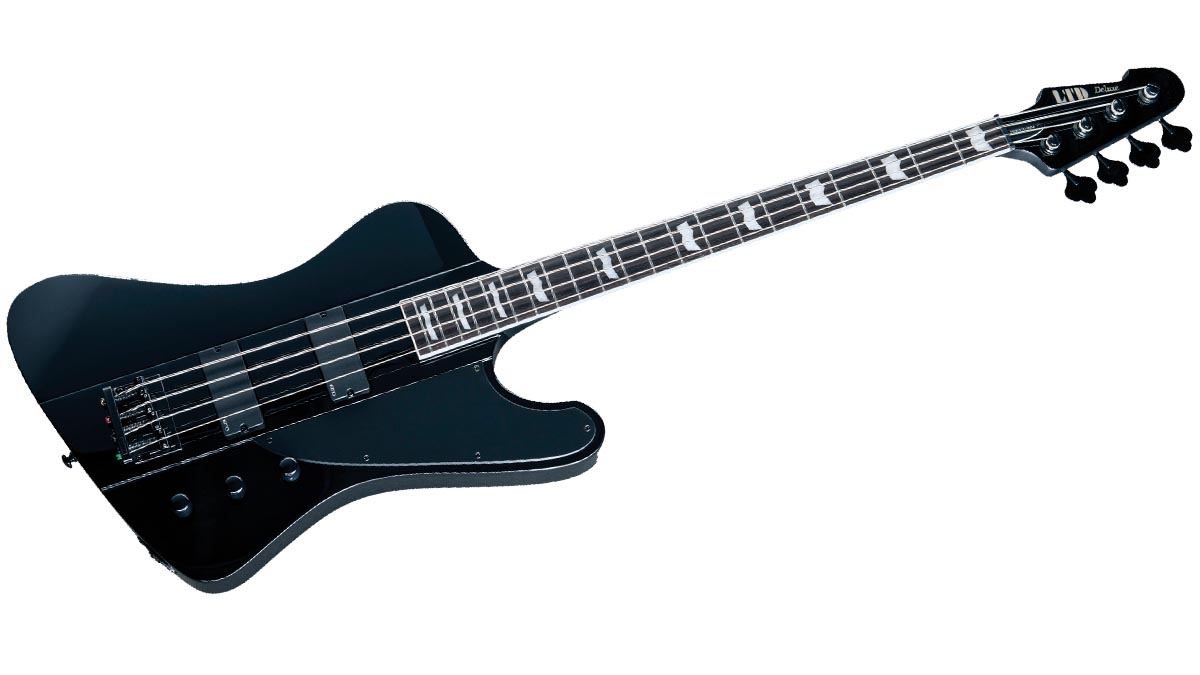Guitar World Verdict
A well-constructed, no-nonsense instrument that sounds as badass as it looks.
Pros
- +
Build quality.
- +
Price.
Cons
- -
None.
You can trust Guitar World
Founded in Tokyo by Hisatake Shibuya in 1975, Electric Sound Products (ESP) began as a small repair shop that made replacement parts for guitars. Rather than chase margins by making cheap replicas, ESP focused on improving quality and design, delivering high-end parts and instruments at competitive prices.
By the mid-'80s, ESP had attracted a luminous roster of guitarists, including Ronnie Wood, George Lynch, Bruce Kulick (Kiss), and Vernon Reid (Living Colour), earning a reputation as a go-to brand for heavy music. It’s hardly a surprise, then, that its basses have followed suit, with ESP counting Tom Araya (Slayer), John Campbell (Lamb Of God), and Marco Mendoza (ex-Whitesnake) among its endorsements.
The company launched its LTD bass guitar range in the mid-'90s to considerable fanfare; lower manufacturing costs in Korea, China and Indonesia allowed ESP to offer exceptional builds at wallet-friendly prices. Exceedingly popular among rock and metal crowds, the original Phoenix offered musicians the notional equivalent of a high-end Thunderbird with active pickups.
Now, after several years of discontinuation, ESP has resurrected the Phoenix with the goal of once again offering musicians a no-nonsense, high-end bass at an affordable price. Let’s see if the new 1004 model matches up.
Build Quality

The Phoenix boasts a full-force mahogany body with a dark satin finish that’s blacker than the heart of Aleister Crowley. Its five-piece mahogany and walnut neck features a thin U-shaped contour and a 34” scale. There are mahogany body wings and a Macassar ebony fingerboard with 21 extra-jumbo stainless steel frets with ESP flag inlays. Its sturdy neck-through construction is designed to ensure a smooth transfer of signal into your amp.
Despite its imperious size, the Phoenix is designed for maximum player comfort. Across the lap, it rests snugly over the thigh, and hung from a strap, it balances easily in both high-up and low-slung positions. The neck sits cosily in the fretting hand and, with the 15.75”-radius fingerboard and the glossy satin finish on the back of the neck, moving between registers is quick and effortless. Many a metalhead will admire the reverse headstock, with its black, vice-grip LTD Vintage tuners.
At the other end, a Gotoh 201B-4 bridge ensures an impressive level of sustain. The control selection is as simple as you like, with volumes for the neck and bridge pickups and a tone control next to the bridge. This all aligns with ESP’s vision for the LTD Deluxe line: a durable build packed with high-quality parts that neatly avoids any hint of overcomplication.

Sounds And Playability
The Phoenix is appreciably versatile, but make no mistake, it is aimed squarely at the heavy hitters: Its active EMG humbuckers uncork an absolute siege of power. Sitting by the bridge, an EMG 35J unleashes a concussive low-end wallop, and with its coil set in the back of the housing, close to the bridge, we’re pleased with the meaty midrange attack and expansive harmonic overtones in the high end. As we hammer away from one metal banger to the next, the Phoenix remains responsive and in tune: We hope the neighbors are enjoying the testing as much as we are.
As the neck pickup, the EMG 35P4 offers a suite of classic and modern tones, with a warm, creamy articulation that actually sounds quite nice with the tone knob in neutral position. It acquits itself admirably playing both blues and some drum and bass pieces, and it’s easy to see the appeal for a gigging musician who might need to switch between styles on the fly.
It would be nice if the tone knob had some sort of mid-point indicator so the player could easily land on a desired setting, but this is a small quibble. Overall, playing the Phoenix borders on guilty-pleasure levels of fun and enjoyment. From the ultra-smooth action of the neck, to the generous jumbo frets, to its superior balance and arsenal of power, the playability is superior.
Conclusion
We could discuss the simple elegance of the Phoenix and how, with its straightforward three-knob control system, you can conjure a vast tonal palette suitable for a wide array of styles. This would be 100 percent true, and if you’re a blues, country or R&B player looking for a versatile bass that’s built to last, then the Phoenix might be for you.
However, with its imposing, blacker-than-black finish, its high-quality construction and a ferocious low end that’s powerful enough to swallow a black hole, the Phoenix is made for heavy music. If you’re looking for a bass that’s reliable, affordable, and a hell of a lot of fun to play, then you won’t do much better than this one.
Specs
- PRICE: $999 / £1,129
- MADE IN: Korea and Indonesia
- BODY: Mahogany
- NECK: Five-piece mahogany/walnut, 34” scale
- NECK JOINT: Neck-through
- FRETBOARD: Macassar ebony
- FRETS: 21
- PICKUPS: EMG 35P4 humbucker (neck), EMG 35J humbucker (bridge)
- ELECTRONICS: Active
- CONTROLS: 2 x volume, tone
- HARDWARE: LTD Vintage tuners, Gotoh bridge
- WEIGHT: 11 lbs
- LEFT-HANDED OPTION AVAILABLE?: Yes
- CASE/GIG-BAG INCLUDED: No
- CONTACT: ESP
“Affordable versions of the three best basses I've ever held in my hands”: Sterling by Music Man completes its trilogy of Joe Dart signature models with a trio of made-to-order basses that cost less than $500
“The ace up the sleeve of bass players around the globe since 1978”: Tobias instruments were trailblazers in the bass world. Now they’re back as part of the Gibson family











